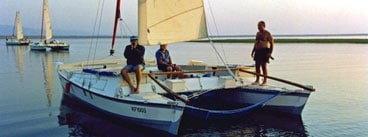
DestAfrica368
An inland lake in Africa is a bizarre place to experience the joys of sailing twin-hulled craft inspired by ancient South Pacific seafarers. But last spring, on Zimbabwe’s man-made Lake Kariba, I set foot for the first time aboard a functional, gaff-rigged catamaran created by James Wharram and his longtime partner, Hanneke Boon. Almost instantly, I understood the
point its designers have been trying to get across for decades: A simple boat can satisfy complex desires.
Though he has the soul of a revolutionary, Wharram didn’t set out to start a revolution. In the mid-1950s, his career aspirations were zero. He had a little money and a lot of wanderlust, and those conflicting realities soon led him down a path from which there was no return. He decided to build a boat.
In the introduction to the recent fourth printing of his highly original book Two Girls Two Catamarans-available on his website (www.wharram.com), which provides fascinating reading in its own right-Wharram described his considerable conundrum: “I was physically strong and mentally extremely self-sufficient. I was living out life problems many of which are still subjects of up-to-date interest and comment: adventure, self-sufficiency from organized society, sex, woman/man relationships, what is human life. All subjects intertwined around the concept that sailing the seas on an ancient canoe-form craft of the Pacific would offer insight into such problems.”
In his quest to become “a modern Polynesian, sailing across the oceans aboard a Polynesian double canoe,” Wharram found insight all right. Let’s just say the “two girls” of the book’s title provided the author with considerable sustenance on multiple levels, as well as a unique roster of challenges. On a parallel plane, it was the two catamarans-a 23-foot-six-inch vessel named Tangaroa followed by a 40-footer called Rongo-that gave Wharram not only the platforms to address his soul’s restless nature but also the seeds of a rich life’s work.
We were in Africa with a Cruising World Adventure Charter. Sadly, the deteriorating political climate in Zimbabwe means it’s a trip we won’t soon offer again. But our days aboard a Wharram Tiki 30 called Biriwiri were magical-a cool little cat on remarkable waters.
Compared with a Caribbean charter cruise, it was more like a camping trip. At night, we’d nose up to the shore, scatter the big cockpit with cushions, hoist the mosquito net aloft on a halyard, and sleep beneath the stars. By day, we’d set out in fresh morning breezes; with a big loose-footed main and furling jib, the boat was fast, stable, and a kick to sail.
Personally, I’d hesitate to take a Tiki 30 offshore. But many (including Wharram) have sailed Wharram designs transoceanic, even around the world, supporting his statement that his boats can “offer ‘Mr. Average Income’ the opportunity to practice Joshua Slocum’s famous dictum, ‘The sea is for sailing on.'”
This month, after a long hiatus, it’s an honor to again present in these pages a story by James Wharram. The young man with the strange boats and the pair of babes has somehow evolved into a man flirting with the mainstream: a living legend and the most prolific multihull designer ever. As far as modern cats go, using ancient principles Wharram found a new way to skin ’em.








